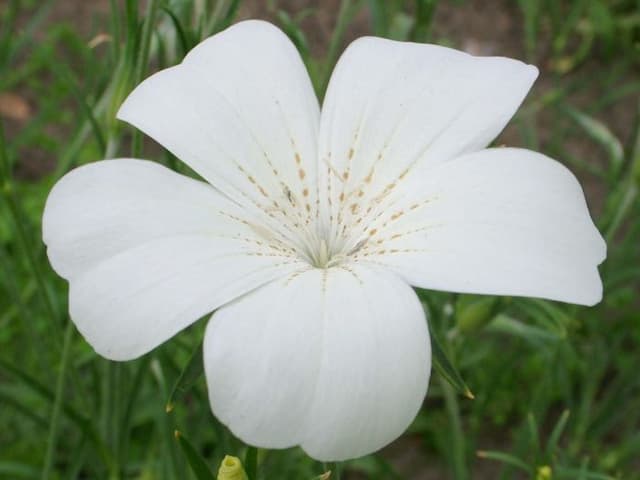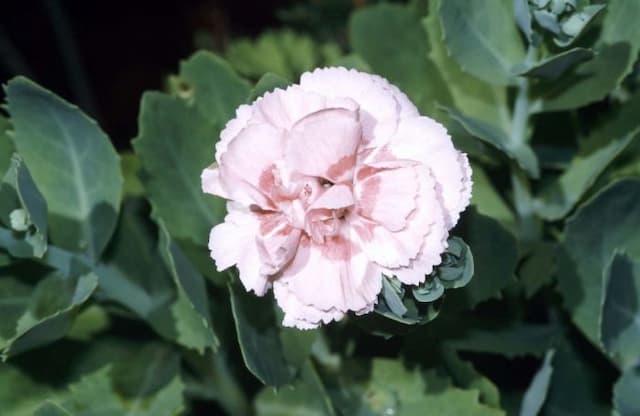Sweet William Dianthus 'Tamsin' (p)

ABOUT
Dianthus 'Tamsin' is a beautiful perennial plant known for its striking flowers and attractive foliage. The plant features a dense cluster of narrow leaves that have a blue-green hue, creating a lovely contrast with the vibrant blooms it produces. These leaves often form a lush mound or tussock that serves as a backdrop for the starry flowers. The flowers of Dianthus 'Tamsin' are particularly eye-catching, typically displaying a range of pink hues, from soft pastel pinks to deeper, more intense shades. The flowers are known for their distinctive form, including five petals that are often fringed or serrated at the edges, giving them a delicate, lacy appearance. Each petal is usually adorned with a unique pattern or markings, sometimes displaying a paler or contrasting eye at the center of the flower. The blossoms emit a delightful spicy fragrance that can attract both humans and pollinators to the garden. These charming flowers are borne atop slender, upright stems that rise from the foliage, creating an appealing display when the plant is in full bloom. The overall look of Dianthus 'Tamsin' is both neat and vigorous, making it a popular choice for garden borders, rockeries, and as a ground cover option, as well as for use in containers or as cut flowers in floral arrangements. Its ability to produce abundant blooms over a long season adds to its appeal, offering color and interest in the garden from late spring through early fall.
About this plant
 Names
NamesFamily
Caryophyllaceae
Synonyms
Pink, Carnation, Sweet William
Common names
Dianthus 'Tamsin'
 Toxicity
ToxicityTo humans
Dianthus 'Tamsin', commonly known as Carnation, generally has a low level of toxicity to humans. However, ingesting any part of the plant can potentially cause mild gastrointestinal discomfort, including symptoms like nausea, vomiting, or diarrhea. Contact with the sap may also cause minor skin irritation in sensitive individuals.
To pets
Carnation can be mildly toxic to pets if ingested. Symptoms of poisoning may include gastrointestinal upset such as vomiting, diarrhea, and possibly a mild dermatitis if there is prolonged skin contact with the plant sap. It is advisable to keep the plant out of reach of pets to prevent any adverse reactions.
 Characteristics
CharacteristicsLife cycle
Perennials
Foliage type
Evergreen
Color of leaves
Green
Flower color
Pink
Height
1 foot (30 cm)
Spread
1 foot (30 cm)
Plant type
Herb
Hardiness zones
7
Native area
Europe
Benefits
 General Benefits
General Benefits- Vibrant Color: Dianthus 'Tamsin' produces striking flowers that add vivid hues to gardens and landscapes.
- Long Blooming Season: It typically has an extended blooming period, providing color and interest over a longer time.
- Attract Pollinators: The flowers are known to attract butterflies and other beneficial insects.
- Low Maintenance: This variety of dianthus is generally easy to care for and does not require a lot of upkeep.
- Drought Tolerance: Once established, it has good drought resistance, which is beneficial for xeriscaping or areas with water restrictions.
- Cold Hardy: The plant can withstand cold temperatures, making it suitable for planting in a variety of climates.
- Pleasant Fragrance: The blooms often emit a delightful scent that can enhance the sensory appeal of a garden space.
- Versatility: It can be used in borders, rock gardens, containers, and as cut flowers, offering numerous landscaping possibilities.
- Evergreen Foliage: Depending on the climate, Dianthus 'Tamsin' may retain its foliage year-round, providing continued interest in the garden even when not in bloom.
- Deer Resistant: This plant is less likely to be eaten by deer, which makes it an excellent choice for gardens in areas prone to deer browsing.
 Medical Properties
Medical PropertiesThis plant is not used for medical purposes.
 Air-purifying Qualities
Air-purifying QualitiesThis plant is not specifically known for air purifying qualities.
 Other Uses
Other Uses- Culinary Garnish: The edible flowers of the Dianthus 'Tamsin' can be used to add a splash of color and mild spicy flavor to salads and desserts.
- Textile Dyeing: The petals of the Dianthus 'Tamsin' can be used to create a natural dye for fabrics, imparting shades of pink and red depending on the mordant used.
- Art Supplies: The crushed petals can be mixed with a binder to create a natural pigment for paints or pastels.
- Perfumery: The essential oils extracted from Dianthus 'Tamsin' can be used in making perfumes due to its lovely, spicy and clove-like fragrance.
- Bookmarks: Dried flowers can be laminated or pressed between sheets of paper to create unique and fragrant bookmarks.
- Potpourri: Dried Dianthus 'Tamsin' flowers can be mixed with other dried botanicals to create potpourri, offering a natural way to scent indoor spaces.
- Crafting: Fresh or dried flowers can be incorporated into crafting projects, such as making floral wreaths or decorating picture frames.
- Decorative Ice Cubes: Freeze the small flowers in ice cubes to create an elegant touch for summer drinks and cocktails.
- Flower Confetti: The petals can be tossed as a biodegradable confetti option at celebrations like weddings or parties.
- Photography: Dianthus 'Tamsin' can be used as a photogenic subject or backdrop in still-life photography, adding color and texture to the composition.
Interesting Facts
 Feng Shui
Feng ShuiThe Carnation is associated with love, fascination, and distinction within Feng Shui. To enhance love and romance, place pink carnations in the southwest corner of your home or bedroom. For promoting healing and energizing personal relationships, the white varieties are well-suited.
 Zodiac Sign Compitability
Zodiac Sign CompitabilityThe Carnation is not used in astrology practice.
 Plant Symbolism
Plant Symbolism- Dianths 'Tamsin' (p) - Carnation:
- Love: Carnations are often associated with love and admiration. Different colors convey different meanings, such as red for deep love and white for pure love.
- Distinction: The flower's patterned petals can symbolize a person's unique qualities, suggesting that everyone is special in their own way.
- Women's Love: In some cultures, carnations are used to celebrate women and are often given on occasions like Mother's Day.
- Good Luck: In certain traditions, carnations are believed to bring good luck, particularly when worn or given at times of celebration.
- Gratitude: The gift of a carnation can be a way to express gratitude or thanks for someone's care or assistance.
 Water
WaterFor the Sweet William, water the plant deeply once a week, ensuring that the soil is moist but not waterlogged. This translates to roughly 1 gallon for outdoor plants and 8-16 ounces for potted plants, depending on the size of the pot and the environmental conditions. During hot, dry periods, you may need to water more frequently, while in cooler or rainy seasons, watering can be reduced. Avoid overhead watering to prevent disease, and instead water at the base of the plant. It is important to let the top inch of soil dry out before watering again to encourage strong root growth.
 Light
LightSweet William thrives in full sun to part shade conditions. The ideal location would receive at least 6 hours of direct sunlight daily, although they can tolerate some afternoon shade, especially in hotter climates. Avoid placing them in deep shade as this will diminish their vibrant blooms and overall health.
 Temperature
TemperatureSweet Williams prefer cooler temperatures and can survive in a temperature range of 40°F to 85°F. They can tolerate some frost and are generally hardy down to about 20°F. The ideal temperature range for growing Sweet William is between 60°F and 70°F. During extreme heat, the plant may go dormant or experience stress, so providing some afternoon shade can be beneficial.
 Pruning
PruningPrune Sweet William to encourage bushier growth and more blooms. After the initial flowering, deadhead spent flowers to promote a second bloom. In late fall, cut back the foliage to a couple of inches above the soil line to help prevent disease and to tidy up the plant. Pruning is generally done on an as-needed basis throughout the growing season and more thoroughly during the plant's dormancy.
 Cleaning
CleaningAs needed
 Soil
SoilCarnations prefer well-draining soil with a pH between 6.5 and 7.5. A mix of loamy soil, sand, and compost or well-rotted manure is ideal, ensuring good drainage and fertility.
 Repotting
RepottingCarnations typically need repotting every one to two years, or when they outgrow their current container.
 Humidity & Misting
Humidity & MistingCarnations thrive in moderate humidity levels. They do not require high humidity and can succeed in average home environments.
 Suitable locations
Suitable locationsIndoor
Place in bright indirect light, well-draining soil.
Outdoor
Full sun, well-draining soil, protect from extreme cold.
Hardiness zone
3-9 USDA
 Life cycle
Life cycleDianthus 'Tamsin' (p), commonly known as 'Tamsin Pink', begins its life as a seed, which under proper conditions of moisture and temperature, will germinate. Upon germination, the plant starts the vegetative stage, with seedlings developing roots and shoots that grow into stems and leaves. As the plant matures, it enters the flowering stage where it produces distinctive pink flowers with a sweet fragrance, which are pollinated by insects to ensure fertilization. Following pollination, the flowers develop into capsules containing seeds, marking the plant's reproductive stage. Seeds are then dispersed, either by wind, animal, or human activities, completing the cycle. In suitable climates, Dianthus 'Tamsin' can often survive winter and enter a period of dormancy before regrowth in spring, thereby behaving as a perennial.
 Propogation
PropogationPropogation time
Spring to summer
The popular method of propagating Dianthus 'Tamsin', commonly known as the Scent First® Tamsin Pinks, is through cuttings, particularly during the late spring or early summer months when the plant's growth is most vigorous. To propagate, a gardener should begin by selecting healthy, non-flowering stems from the Scent First® Tamsin Pinks and cut a piece about 4-6 inches (10-15 cm) in length. The lower leaves are then stripped off, and the cutting is dipped in rooting hormone to encourage root development. This prepared cutting is then planted in a well-draining soil mix, ensuring that the leaf nodes (from where the leaves were removed) are buried as these areas are where the roots are most likely to develop. The cuttings should be kept moist and in a warm environment with indirect light until roots have established, after which they can be transplanted into individual pots or into the garden.








![Pink [Bubblegum]](/_next/image?url=https%3A%2F%2Fplants-admin.emdemapps.com%2Fimages%2Fplants%2F%2Fimages%2F604b596f31cbb.png&w=640&q=75)
